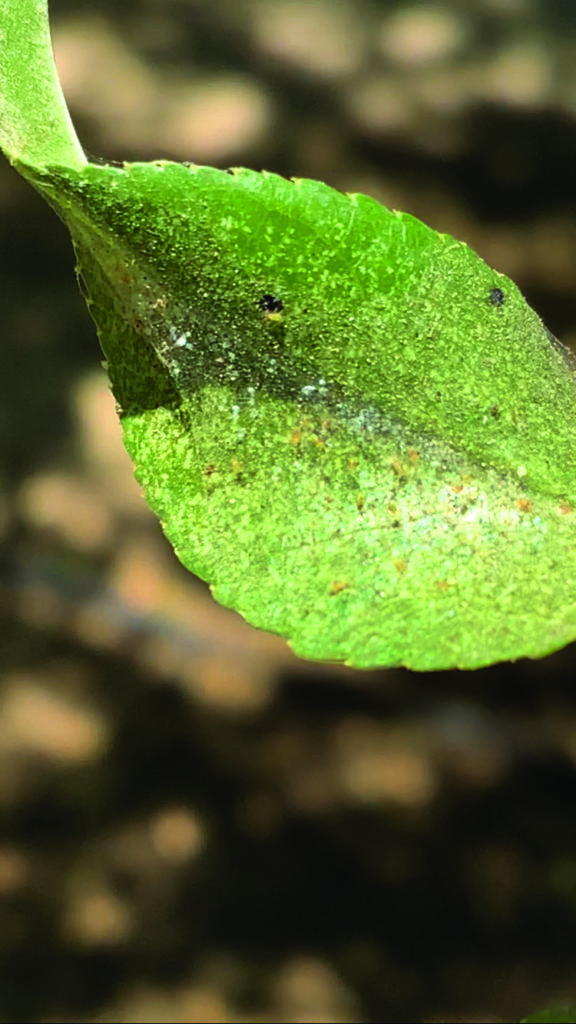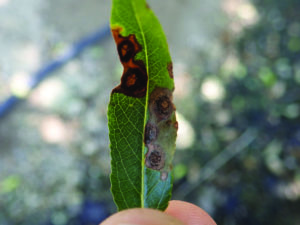
July/Aug 2022
Summer struggles for California almonds
So far, this year is proving to be a difficult one for almond growers in California. Diseases and pests triggered by uncontrollable environmental factors and new spray standards pose challenges, causing pockets of increased pest pressures.
“Alternaria is coming on crazy heavy right now, and far earlier than it normally does,” said Kevin Caffrey, technical services representative for BASF. “We got a little bit of rain early that added some leaf moisture, and then alternaria just took off.”

Alternaria is one of the most common fungi that threaten almond orchards and thrives when the temperatures are high and the leaves are wet. Though the temperatures didn’t start off extreme, some fields are already starting to defoliate – much earlier than usual. As of early June in the Central Valley, North Valley didn’t seem to have too much alternaria yet, though typically it shows up in this region a bit later in the season.
South Valley is struggling with mites, which began appearing in May. The brief temperature spike in May, when there were a few days over 100 degrees, seemed to bring out the mites in force.
Managing them is difficult, as they seem to thrive in conditions created by other preventative sprays.
“I think part of that may come from the new USDA Standards for leaffooted plant bugs,” said Caffrey. “A lot more people are spraying pyrethroids early. And when they spray pyrethroids early, they blow out their six-spotted thrips, and then, if it’s conditioned properly for mites, the mites explode. So, unfortunately, trying to control one pest may be exacerbating a second pest.”
Caffrey said he’s concerned with how the fields will fare between now and harvest. The mites are abundant, and they’re even being seen in fields that are sprayed with pyrethroids.
“The other scary thing is that temperatures are only going to increase, as we know, and with the water issues we’re facing, a lot of people are going to have to cut their water off at some point,” he said. “So that means more tree stress, and more tree stress means more mites. So it’s gearing up to potentially be a bit of a struggle.”
For growers hoping to mitigate damage from mites, they’re up against the dilemma of spraying to prevent one pest or spraying to usher in another one. But spraying those early pyrethroids is essentially unavoidable for growers who have leaffooted plant bug.
“Those standards are so high for injury that you just have to spray,” he said.
There are currently no softer options available, but Caffrey said the best growers can do is try to keep their beneficials.
“If you have to spray, you have to spray; there’s no question for leaffooted plant bug or stink bug. But as quickly as you can afterwards, try to rebuild your beneficial population.
Try to keep to the softer miticides, so your predatory mites and some of your six-spotted thrips populations start to grow, so when you get to hull split and start shutting off water for deficit irrigation, or you run out of water, you’re not in a mess.”
Additionally, getting good coverage is of the utmost importance.
“If you’re going with the old mentality of 100 gallons of water and going four miles per hour through a field to get it done, you’re going to have a huge issue,” said Caffery.
Slowing down, keeping the water up, and aiming to get the best coverage possible out of every application is key. While it’s not cheap, it will ultimately be costly to do a quick job the first time around, as it could mean more applications or injury to the trees.
Caffrey is unsure what next year will look like, but he anticipates having to find a new normal for dealing with mites in the wake of the new USDA Standards for leaffooted plant bugs. That will likely have to come from softer options, many of which are being explored.
“Are there potentially some pyrethroids that are maybe a little softer? Is there a way to maybe not treat adjacent fallow areas, but be able to manage the weeds a little better, keep a little boundary, or could there even be some way of having a sanctuary area to pull (pests) into?” said Caffery. “There’s a lot of different options, but I think we have to start getting creative. Because unfortunately on the chemistry side, there aren’t a lot of soft options for a big pest like stink bug or leaffooted plant bug.”
One control method growing in popularity is trap crops, which Caffrey said is a smart move, but also one that would require a concerted effort in order to be most effective. Whereas the big growers could manage trap crops on their own, Caffrey thinks people with 40, 60 or 80 acres of crops would need to be taken care of by some kind of higher-up – whether the county or something similar – as most of those farms wouldn’t have enough space to grow their own trap crops.
For now, the northern parts of the Central Valley seem to be dealing mostly with the typical problems with weeds, but faring okay with diseases and pests. This could change as the summer goes on and brings higher temperatures.
“With alternaria and mites, everything starts in the south,” Caffrey said. “That’s where most pressures begin.”
Some areas are experiencing very high mite pressure, often associated with early pyrethroid and abamectin applications. Photos: BASF







